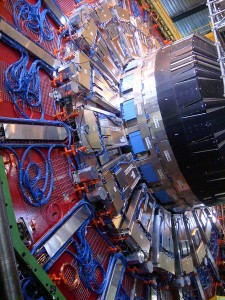Hadrons, Rap and Holes in the Ground
by Heather Pringle
September 12, 2008
 Like many other people, I was fascinated this week by the massive news coverage of the Large Hadron Collider (LHC), the $9 billion-dollar atom smasher designed to replicate forces in the universe a split second after the Big Bang.  What might otherwise have been a story suitable only for scientists interested in the origins of matter became a huge media event. Reporters reveled in all the angles: the quest for the brilliantly branded “god particle;†the colorful doomsayers who predicted the LHC would create a black hole capable of swallowing Earth; the staggering scale of the project which involved something like half the world’s physicists; and the heated controversy between famous scientists, including the media-savvy Stephen Hawkings. The LHC even generated a clever rap song, posted on You Tube.Â
Like many other people, I was fascinated this week by the massive news coverage of the Large Hadron Collider (LHC), the $9 billion-dollar atom smasher designed to replicate forces in the universe a split second after the Big Bang.  What might otherwise have been a story suitable only for scientists interested in the origins of matter became a huge media event. Reporters reveled in all the angles: the quest for the brilliantly branded “god particle;†the colorful doomsayers who predicted the LHC would create a black hole capable of swallowing Earth; the staggering scale of the project which involved something like half the world’s physicists; and the heated controversy between famous scientists, including the media-savvy Stephen Hawkings. The LHC even generated a clever rap song, posted on You Tube.Â
As I thought about this, I found myself wondering why archaeologists have failed to capture the public imagination in quite the same spectacular way. If number-crunching, pocket-protector physicists can figure out how to turn one of their experiments into a huge buzz among everyone from young rappers to jaded newspapers editors, why can’t archaeologists do the same?Â
Some might scoff, but this is no idle question.  The new media—where many people increasingly get their news—place a huge emphasis on what is happening now, in the present tense. To many teenagers and young adults, events that took place even 50 years ago now seem dull and irrelevant.   This, of course, is very bad news for archaeologists, who need public funding and public interest to keep expensive digs going.Â
Perhaps it’s high time they take a page from the book of the physicists. Instead of keeping their noses to the ground and designing only small excavations, how about a massive new archaeological project, something that will combine the efforts of hundreds of researchers and engage the imagination of the public? Lord knows, archaeologists have wonderful material to work with—real human beings as opposed to subatomic particles.  And there are no lack of big questions out there: Who were the first modern humans and where did they come from? How did modern humans migrate across the face of the earth and colonize even the harshest ecosystems? How has humanity adapted to extreme climate change in the past? Â
The new media are rapidly changing how people view the world, and I’d hate to see archaeologists left behind. Black holes have nothing on excavators’ holes in the ground. Let’s find a project that will set even the rappers rhyming. Â
Â
This entry was posted by Heather Pringle on
Friday, September 12, 2008.
Discussion of this blog entry is now closed.
Comments posted here do not represent the views or policies of the Archaeological Institute of America.

